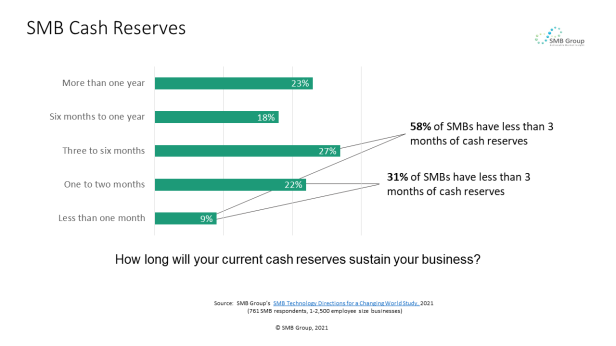 —by Kelly Teal, SMB Group Contributing Analyst, and Laurie McCabe, SMB Group Co-founder
—by Kelly Teal, SMB Group Contributing Analyst, and Laurie McCabe, SMB Group Co-founder
2020 was a rough year for many small and medium businesses (SMBs). According to U.S. Federal Reserve economists, the pandemic led to the permanent closure of about 200,000 more businesses in 2020 than in recent years.
When SMB Group surveyed SMBs in July 2020, more than half said that their average monthly revenues had decreased after the pandemic hit, and only 15% said revenues had increased. As the year came to a close, however, 43% reported that 2020 revenues had exceeded 2019 revenues. Just over one-third managed to break even, and 20% suffered a year-over-year decline. On the whole, smaller businesses were more likely to have suffered a downturn in revenues than their larger counterparts.

Midway through 2021, pandemic concerns are subsiding, and a majority of SMBs are more optimistic about their prospects for this year—but times remain unpredictable. Even though the pandemic is easing within the United States, supply chains face shortages and employers can’t find enough people to hire. Running out of money is a small business’s biggest risk. According to the U.S. Small Business Administration (SBA), inadequate cash reserves and/or running out of money is a top reason that startups fail.
However, cash flow challenges extend beyond startups. According to SMB Group research, 31% of surveyed SMBs have only one to two months of cash reserves available to sustain their businesses, while 58% have only three to five months of working capital.

If your business is hit with a cash crunch, you may not be able to pay employees, vendors or yourself on time, or have the necessary cash to invest in a new project. A lack of working capital can prevent you from acquiring the resources you need to take on new work and customers. When this happens, your competitors will step in to offer alternatives—and once they do, it will be difficult to win over the customers you’ve lost to those competitors.
Ways to Increase Cash Flow
Most experts agree that businesses need at least six months of cash reserves to weather adversity. However, as the data tells us, most companies do not have that much cash on hand, and it can be difficult to create that cushion when money is already tight.
Many SMBs turn to loans and credit lines to bolster their cash reserves. During the pandemic, more than 50% of SMBs surveyed by SMB Group took advantage of the first round of U.S. Paycheck Protection Program (PPP) loans to help them sustain operations. Looking ahead, about one-third of surveyed SMBs have applied, or intend to apply, for funding in 2021.
However, loans aren’t always the right solution. Sometimes businesses just need to smooth out their cash flow, and loans are overkill. In other situations, businesses require additional financing beyond loans. Smaller SMBs are also typically more wary of taking on debt and paying interest, and/or they often find it harder to qualify for loans. In fact, fewer than 20% of businesses with 1 to 19 employees surveyed by SMB Group took advantage of the first round of PPP loans, and fewer than 20% of companies of that size plan to seek additional funding in 2021.
Fortunately, there are other steps SMBs can take to improve and maintain their cash flow. Consider these ideas as starting points to ease cash flow problems and bolster reserves:
- Speed up accounts receivable payments. According to a QuickBooks Study, one-third of U.S. small businesses estimate that their company has more than $20,000 in outstanding receivables. To speed up the receipt of payments, bill customers as early as possible and perhaps even adjust your payment terms. For example, think about adding options for early payment discounts and/or requiring an up-front deposit before you start work. Finally, think about swapping out paper invoices for electronic ones and accepting credit card and Automated Clearing House (ACH) payments.
- Delay payables. Try to arrange installment plans or extended payment timelines with suppliers. When it comes to payroll, choose a provider that pulls the money close to payday, rather than two weeks or more in advance, so you can hold on to the money longer.
- Curb costs. When possible, buy items you know you will use in bulk at a discount, and choose refurbished equipment over new. Assess company spending on subscription services—from mobile phones to cloud applications—to ensure that you’re not wasting precious money on services that no one is using or benefiting from. Limit or avoid impulse purchases too.
- Sell stuff. Many businesses have really shifted gears due to the pandemic and are adapting once again as the economy recovers. Chances are, your business owns equipment, furniture or other assets you no longer need or use—but someone else can. Selling the excess boosts your cash coffers and frees up space. Alternately, consider donating items for a tax write-off.
- Accept more types of payment. Increase cash flow by accepting more forms of payment, which makes it easier and quicker for customers to buy from you. Credit cards, online e-commerce payments, bank-generated electronic checks and even digital currency can bring cash in faster. (A caution on Bitcoin and its ilk: The Internal Revenue Service taxes cryptocurrency and expects businesses to report it.)
Getting More from Credit Card Transactions
Credit cards can be a great way to guarantee you get paid right away and to help finance expenses. Although interest rates are high, most cards don’t charge interest for 30 to 45 days if you pay off the current balance. This can help you finance large expenses for materials, manufacturing, inventory, office expenses and commercial lease payments. Paying for large-sum purchases via credit card also allows you to take advantage of vendors’ volume discounts, while simultaneously earning credit or debit card points and cash rewards.
Now there’s a way to extend these benefits. Plastiq’s payment platform lets you pay for virtually any expense by card—even if the merchant you’re paying doesn’t accept credit cards. Plastiq manages the payment process by billing your card and transferring the money to your payee in the method of their choosing (check, wire or ACH), so everyone’s happy.
Here’s how it works:
You set up a free Plastiq account, add a credit card of your choosing and pay for a transaction using your card. Plastiq then pays that company on your behalf—and in your name—using the payment method that the seller prefers. Note that the recipient does not need a Plastiq account to receive the payment.
Furthermore, Plastiq customers can view and manage their payables and receivables all in one place in the Plastiq app. You can connect your Plastiq account with QuickBooks Online to import bills, suppliers and invoices as well as to sync transactions, enabling automatic and seamless expense reconciliation. In addition, you can set up roles and permissions to integrate workflows and protect access to sensitive data, which makes the bookkeeper’s work faster, easier and more accurate—and gives you a clear picture of the financial health of your business.
Plastiq helps you build working capital, as using a credit card that features some period of 0% interest reduces your costs. And although Plastiq charges a 2.85% fee for credit card transactions, card rewards can help offset those fees—so can tax deductions. According to Plastiq, a portion of its fees were tax-deductible as business expenses in 2020.
Perspective
Through the good times and the bad, cash is king—and adequate cash flow is vital to business longevity. As economic conditions improve, SMBs should avail themselves of every tool in the cash flow toolbox to build up cash reserves.
Growing your cash supply now will provide your business with more breathing room when unexpected adversity hits, more capital at your fingertips to take advantage of new opportunities, and improved peace of mind.
This post is sponsored by Plastiq.
© SMB Group, 2021
Source: Laurie McCabe’s Blog
